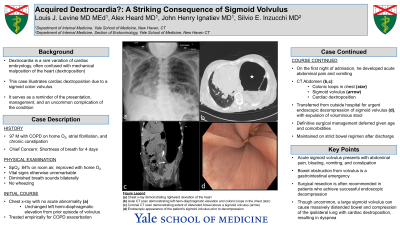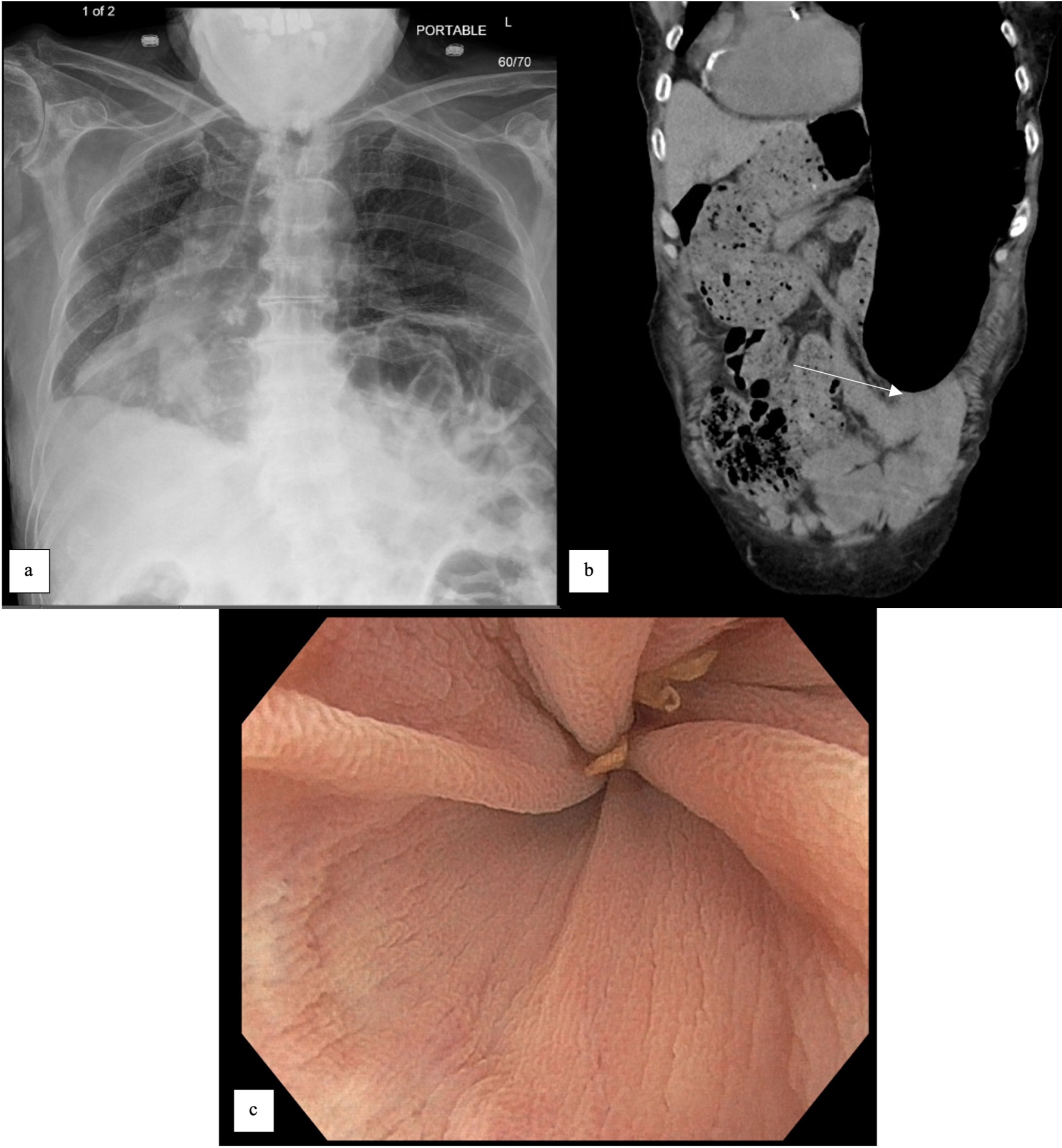Back


Poster Session D - Tuesday Morning
Category: Colon
D0118 - Acquired Dextrocardia?: A Striking Consequence of Sigmoid Volvulus
Tuesday, October 25, 2022
10:00 AM – 12:00 PM ET
Location: Crown Ballroom

Has Audio
- LL
Louis J. Levine, MD, MEd
Yale University School of Medicine
New Haven, CT
Presenting Author(s)
Louis J. Levine, MD, MEd, Alex Heard, MD, John Henry Ignatiev, MD, Silvio E. Inzucchi, MD
Yale University School of Medicine, New Haven, CT
Introduction: Dextrocardia is a rare variation of cardiac embryology. Mechanical malposition of the heart in the right chest by adjacent structures is often confused with dextrocardia. This case emphasizes the distinction by illustrating a right-sided heart due to a sigmoid colon volvulus. The case reminds us of the presentation, management, and an uncommon complication of sigmoid volvulus.
Case Description/Methods: A 97 year-old man with chronic obstructive pulmonary disease (COPD) on home oxygen, atrial fibrillation, and chronic constipation presented to an outside hospital after 4 days of exertional shortness of breath. He was hypoxic with SpO2 of 84% without use of home oxygen, which improved with nasal cannula. His admission exam noted diminished breath sounds bilaterally but no wheezing. Chest radiography showed no acute abnormalities, but chronic left hemi-diaphragmatic elevation with stable mediastinal shift, seen on recent studies (Figure 1a). He was treated empirically for COPD exacerbation.
That evening, however, he developed acute abdominal pain and vomiting. A CT scan of the abdomen was performed and re-demonstrated left hemi-diaphragmatic elevation with several colonic loops extending into the chest, resulting in rightward deviation of the heart. However, there was also a new abrupt caliber change just proximal to the descending colon and sigmoid junction where apparent twisting of the mesocolon was noted, concerning for volvulus, a condition that the patient had in fact experienced previously (Figure 1b). The patient was urgently transferred to our hospital for surgical evaluation.
Upon arrival, the gastroenterology service was consulted, and the patient underwent endoscopic decompression of a sigmoid volvulus (Figure 1c). After decompression, he was kept on a strict bowel regimen and discharged. Definitive surgical management was deferred given the patient’s age and comorbidities.
Discussion: A sigmoid volvulus can present with abdominal bloating, pain, vomiting, and constipation. Bowel obstruction secondary to sigmoid volvulus is a gastrointestinal emergency. For patients who achieve successful endoscopic decompression, surgical resection of the sigmoid is often recommended. Though uncommon, the patient in this case also had shortness of breath, possibly related to distended bowel causing diaphragmatic elevation and compression of the ipsilateral lung. This level of bowel distension resulted in a noteworthy rightward deviation of the mediastinal contents, including the heart.

Disclosures:
Louis J. Levine, MD, MEd, Alex Heard, MD, John Henry Ignatiev, MD, Silvio E. Inzucchi, MD. D0118 - Acquired Dextrocardia?: A Striking Consequence of Sigmoid Volvulus, ACG 2022 Annual Scientific Meeting Abstracts. Charlotte, NC: American College of Gastroenterology.
Yale University School of Medicine, New Haven, CT
Introduction: Dextrocardia is a rare variation of cardiac embryology. Mechanical malposition of the heart in the right chest by adjacent structures is often confused with dextrocardia. This case emphasizes the distinction by illustrating a right-sided heart due to a sigmoid colon volvulus. The case reminds us of the presentation, management, and an uncommon complication of sigmoid volvulus.
Case Description/Methods: A 97 year-old man with chronic obstructive pulmonary disease (COPD) on home oxygen, atrial fibrillation, and chronic constipation presented to an outside hospital after 4 days of exertional shortness of breath. He was hypoxic with SpO2 of 84% without use of home oxygen, which improved with nasal cannula. His admission exam noted diminished breath sounds bilaterally but no wheezing. Chest radiography showed no acute abnormalities, but chronic left hemi-diaphragmatic elevation with stable mediastinal shift, seen on recent studies (Figure 1a). He was treated empirically for COPD exacerbation.
That evening, however, he developed acute abdominal pain and vomiting. A CT scan of the abdomen was performed and re-demonstrated left hemi-diaphragmatic elevation with several colonic loops extending into the chest, resulting in rightward deviation of the heart. However, there was also a new abrupt caliber change just proximal to the descending colon and sigmoid junction where apparent twisting of the mesocolon was noted, concerning for volvulus, a condition that the patient had in fact experienced previously (Figure 1b). The patient was urgently transferred to our hospital for surgical evaluation.
Upon arrival, the gastroenterology service was consulted, and the patient underwent endoscopic decompression of a sigmoid volvulus (Figure 1c). After decompression, he was kept on a strict bowel regimen and discharged. Definitive surgical management was deferred given the patient’s age and comorbidities.
Discussion: A sigmoid volvulus can present with abdominal bloating, pain, vomiting, and constipation. Bowel obstruction secondary to sigmoid volvulus is a gastrointestinal emergency. For patients who achieve successful endoscopic decompression, surgical resection of the sigmoid is often recommended. Though uncommon, the patient in this case also had shortness of breath, possibly related to distended bowel causing diaphragmatic elevation and compression of the ipsilateral lung. This level of bowel distension resulted in a noteworthy rightward deviation of the mediastinal contents, including the heart.

Figure: Figure 1. (a) Chest plain x-ray film demonstrating rightward deviation of the heart. (b) Coronal CT scan demonstrating the extent of distended bowel above a sigmoid volvulus, see arrow. (c) Endoscopic appearance of the patient’s sigmoid volvulus prior to decompression.
Disclosures:
Louis Levine indicated no relevant financial relationships.
Alex Heard indicated no relevant financial relationships.
John Henry Ignatiev indicated no relevant financial relationships.
Silvio Inzucchi indicated no relevant financial relationships.
Louis J. Levine, MD, MEd, Alex Heard, MD, John Henry Ignatiev, MD, Silvio E. Inzucchi, MD. D0118 - Acquired Dextrocardia?: A Striking Consequence of Sigmoid Volvulus, ACG 2022 Annual Scientific Meeting Abstracts. Charlotte, NC: American College of Gastroenterology.
